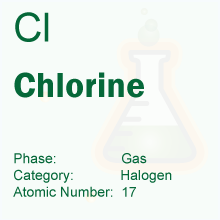 Periodic Table -> Chlorine
Periodic Table -> ChlorineChlorine
Chlorine DetailsChlorine Symbol: Cl
Chlorine Atomic Number: 17
Chlorine Atomic Weight: 35.453
What is Chlorine?
Chlorine (Cl, atomic number 17) is a halogen element, poisonous greenish-yellow gas. Occurs widely in nature as sodium chloride in seawater, but it can be very dangerous depending on how it is used. It is most frequently found as chloride, as in sodium chloride, another name for your everyday table salt. The chloride ion itself is part of the salt in the earth and in the oceans. In fact, almost 2 percent of the seawater mass is made of chloride ions, and even more than that in the Dead Sea, which we all know is extremely salty. With close to 34 percent of salinity, Dead Sea is among the saltiest water bodies. Discovered by Karl Scheele in 1774. Humphrey David confirmed it as an element in 1810.
Since chloride is generally soluble in water, large quantities of substances that contain chloride are usually only found in dry climates or deep under the ground, like in the Earth's crust. Chlorine is present in very high concentrations there. It is mostly found in minerals like halite, sylvite, and carnallite.
Chlorine has many isotopes, the main ones being 35Cl (75.77 percent) and 37Cl (24.23 percent). They form the atomic weight of the element, which is 35.4527 g/mol.
Chlorine has a very important scientific function – it is useful for geologic dating because of its half-life of 308,000 years. This means twice as many years have to pass before traces of it in the environment are lost. It can also be used to date waters less than 50 years before the present. It has been used to date ice and sediments as well. The amylase enzyme contains a chloride ion, while calcium chloride, a compound of chlorine, is used to reduce dampness in rooms. To this purpose, it is produced in pellet form. Calcium chloride has other applications, being used for sanite fortifying roadbases and to maintain unpaved roads.

Chlorine is widely used in industry and household products. It can be very dangerous sometimes, especially when it is in the form of gas. In order to transport the chlorine gas, it must be pressurized and converted into liquid form, and when the liquid is released, it turns into a gas, which spreads very quickly. It has a pungent, unpleasant smell, like that of bleach. This smell can be an advantage because it can alert people to the presence of the gas. Another warning sign that the gas is present is its greenish-yellow color. Chlorine forms explosive compounds with some chemicals, but it is not flammable in itself.
The gas was used during the First World War as a weapon to induce choking. Today, it is used in pesticides, rubber, solvents, and in swimming pool water against bacteria (that is why, your eyes sting, and it is mandatory to wear goggles almost everywhere). It is also used for sanitation purposes, like in garbage processing. Keep in mind that your everyday chlorine bleach, if mixed with other chemicals for cleaning, can transform into a chlorine gas. Practice caution when you are using it for whatever reason.
Finally, chlorides are used in the petroleum industry. They are a component of the mud system and are closely monitored. When the amount of chlorides increases in the mud system, this can be a signal that drilling into salt-water formations, characterized with high pressure, is possible. The increase of chlorides, however, can also signal that the target sand is of poor quality.
You can
link to this page, using the code below:
Periodic Table |
Banks
© ElementsDatabase.com 2015 | Privacy | About | Contact